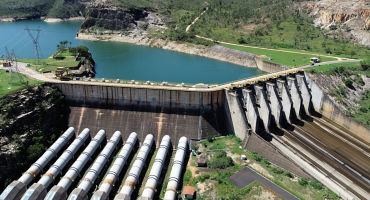- Investment Director
Skip to main content
- Funds
- Insights
- Capabilities
- About Us
- My Account
Our Funds
Fund Documents
Global Multi-Strategy Fund
The views expressed are those of the authors at the time of writing. Other teams may hold different views and make different investment decisions. The value of your investment may become worth more or less than at the time of original investment. While any third-party data used is considered reliable, its accuracy is not guaranteed. For professional, institutional, or accredited investors only.
We expect the transition toward a net-zero carbon economy to speed up in the face of intensifying effects from climate change alongside regulatory and societal pressure. Investors need and want to be part of the solution, as evidenced by initiatives such as the Net Zero Asset Managers initiative — of which Wellington is a founding member — and the growing demand for climate strategies.
However, moving from intent to implementation is challenging. Here, we explore some options to score an investment “hat-trick” by 1) accessing compelling return potential, 2) decarbonizing portfolios and economies, and 3) financially supporting climate solutions, thereby reducing the potential for longer-term climate risks.
Climate change now constitutes an existential risk. Even if we manage to decarbonize quickly, adverse climate consequences are now unavoidable, leaving many assets exposed to physical risk. We think that many assets are mispriced as poor climate-related disclosures make it hard for investors to identify the associated risks and opportunities. Behavioral biases also hamper accurate price discovery, with markets tending to project historical patterns forward. This anchoring results in a gross underappreciation of the frequency of climate events and the magnitude of demand for solutions that can help respond to climate risks.
The wholesale shift to a net-zero world is likely to accelerate transition risk. Assets of companies unwilling or unable to lower emissions may be hit by a brown discount as markets reprice them downwards for increased financial risk due to higher costs of capital, capital expenditures, litigation risks, and potential carbon taxes. As a result, these assets could ultimately become stranded. Favoring decarbonization leaders and engaging with laggards to encourage them to adopt best practices in transition risk management helps not only to mitigate portfolio-level climate transition risk but also to decarbonize portfolio exposures.
Importantly, decarbonization need not be achieved through large-scale divesting or restricting exposure to heavy carbon emitters. Instead, we believe active engagement on the topic of transition risk management and science-based emission reduction targets may translate into similar levels of decarbonization over time without compromising returns or other economic objectives. Active engagement should also help to accelerate the economy’s overall transition.
Climate change is already leading to significant demand for solutions and we expect this to increase substantially as the realities of climate change start to bite. Channeling capital toward these solution providers helps not only to expand capacity and incentivize talent, but also to curb longer-term climate risks, while providing investors with exposure to significant long-term return potential. Solutions are wide ranging and fall into three broad categories:
Mitigation: products and services that reduce the use of energy
Transition: products and services that draw on greener sources of energy
Adaptation: products and services that build resilience to the threats of physical climate risk
We estimate the public equity climate opportunity set across these categories currently includes approximately 850 companies, representing US$13.6 trillion in market value. In private equity, climate innovation is taking shape as an asset class in its own right, with more than 3,000 clean-tech startups. This segment is attracting significant capital: For instance, in the first half of 2021, 600 climate tech startups raised US$60 billion, a 200% year-over-year increase.1
In our view, an elegant method of achieving all these objectives is investing in a range of climate solutions, specifically those for which portfolio managers commit to engaging with portfolio companies on their transition plans. With such an approach, portfolios access the breadth of climate opportunities, position themselves ahead of secular climate trends, and decarbonize organically over time.
We illustrate how that may work in practice with two potential exposures for the public equity component of a climate-solutions portfolio. Both components enable investors to focus on the opportunities associated with climate mitigation and adaptation, while reducing transition risk. However, they come with distinct characteristics that fit different investor profiles.
Our research shows higher-than-expected and sustained growth for many types of climate solution companies. While a significant proportion of companies will be small- to mid-cap size, they are not exclusively so. Figure 1 illustrates some examples of where we expect to find higher-growth climate solutions:
We expect that innovation will continue to create new high-growth opportunities, though we recognize that the road toward low carbon will be bumpy. Many technologies still need to be tested, and we expect many may not scale well. As a result, investors should expect that these types of high-growth exposures may be volatile and produce less income.
For investors who favor more consistent return profiles, a diversified approach that invests in both high-growth and consistent-growth approaches may be more appropriate. Perhaps surprisingly, there are many climate solutions companies with well-established income streams. In fact, a large number of these companies will be essential to the success of the transition to zero carbon — for instance, certain electric utilities and infrastructure companies that will play key roles in facilitating the transition. By incorporating this type of exposure within a climate solutions allocation, investors can potentially capture more consistent returns, driven by the persistent and growing need to adapt and transition to a lower carbon economy.
Figure 2 illustrates the scale of the opportunity through the International Energy Agency’s2 projections of investment for different forms of energy. It shows that electrical networks are likely to benefit from major investment, even ahead of renewables.
While some of these investments may add scope 1 and 2 greenhouse gas emissions to portfolios in the short- to mid-term, many of these companies are well positioned to help lower scope 3 emissions longer term across the wider economy and help accelerate the transition to net zero. As a result, exposure to those types of assets should help investors decarbonize their portfolios, while still enjoying relatively reliable income streams.
As a next step, these “core” allocations could be complemented by a satellite exposure to the growing number of private companies that are developing workable climate solutions.
Decarbonizing the economy is a long-term process, and repositioning portfolios will likewise take time. But we believe it is important that investors act now to take advantage of the compelling return opportunities associated with this secular change. By balancing the return profile of both high-growth and consistent-growth climate solutions, investors can, in our view, generate a more consistent return profile while also taking a meaningful step toward decarbonizing their portfolios. In addition to a diversified climate solution allocation, our climate-aware strategic asset allocation framework offers a roadmap to guide investors on additional ways to manage climate risks across portfolio exposures.
1“State of climate tech 2021: Scaling breakthroughs for net zero,” PWC, 2021.
2World Energy Outlook 2021, Announced Pledges Scenario, International Energy Agency, October 2020.
Please refer to the investment risks page for information about each of the following risks:


Impact measurement and management: addressing key challenges
Continue readingDecoding impact expectations: best practices for impact investors and companies
Continue readingURL References
Related Insights
Stay up to date with the latest market insights and our point of view.

2024 Climate Report
Aligned with TCFD recommendations, this report describes how we manage climate-related risks and opportunities, engage with companies on climate change, and reduce our own carbon footprint.

2024 Sustainability Report
We appreciate the opportunity to share our approach to advancing sustainable practices across our investment, client, and infrastructure platforms.

Measuring impact in venture capital
We highlight why venture capital matters to impact investors and how to authentically measure and manage impact in this asset class.

Impact measurement and management: addressing key challenges
Our IMM practice leader describes common impact investing challenges and suggests ways to overcome them.

Decoding impact expectations: best practices for impact investors and companies
We share three recommendations each for impact investors and companies to help them better understand and manage each other's expectations.

Impact measurement and management practices
What constitutes an impact investment? How is impact measured? And, what are the benefits of impact investing? Our Impact Management and Measurement Practice Leader Oyin Oduya discusses our approach.

Assessing the impact of climate resilience
Oyin Oduya and Louisa Boltz discuss the case for impact solutions focused on climate adaptation and share high-level guidelines to help overcome the associated measurement challenge.

Commodities and the energy transition: Symbiosis for the future
The global energy transition is driving demand for commodities. Our experts explain which ones will be needed most.

Impact investing in emerging markets: Growing opportunities, shifting challenges
Members of our impact bond team discuss their evolving emerging markets opportunity set and the importance of a bottom-up approach to value creation.

Why an impact lens is an important tool in the fixed income investor's arsenal
Campe Goodman, Will Prentis and Oyin Oduya discuss how an impact lens can be an important tool in the fixed income investor's arsenal.

Picking the right building blocks for a climate-aware portfolio
For asset owners integrating climate change into their multi-asset portfolios, members of our Investment Strategy & Solutions Group offer five important insights.
URL References
Related Insights